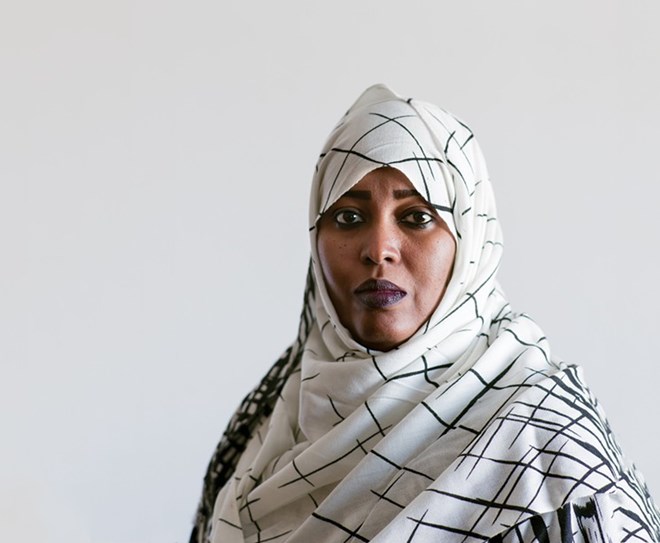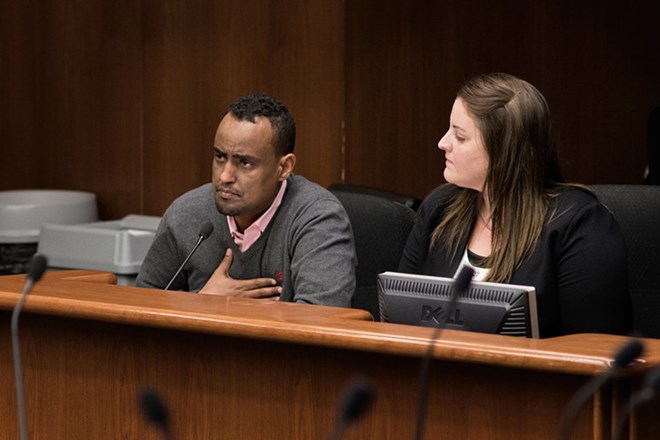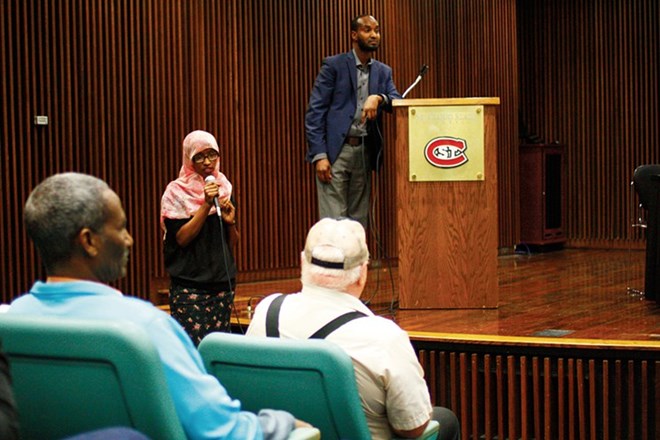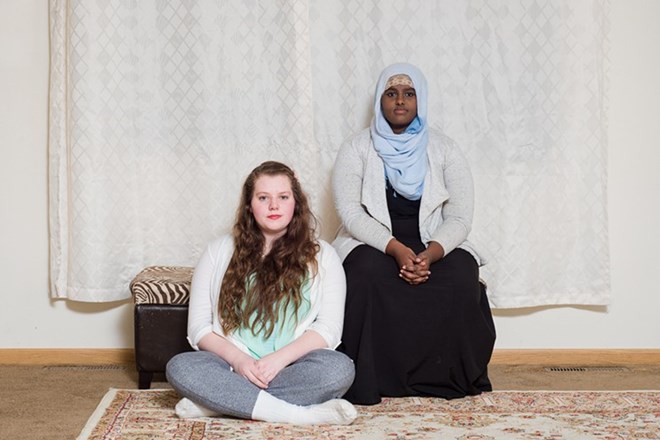
Friday January 22, 2016
By Susan Du

Lul Hersi has lived in St. Cloud for 14 years, but has been confronted as if she arrived only recently, and only to benefit from welfare handouts.
Lul Hersi sat in her idling minivan at a stoplight in downtown St. Cloud. Her window was rolled down to invite in the evening summer breeze, her phone tucked in her hijab, against her ear, like a makeshift Bluetooth receiver."Hey, you!" a woman's voice suddenly brayed from the next car. "Hey, you! I'm talking to you, Somalian lady."
Hersi turned to find a white woman leaning out the passenger window, her eyes piercing with confrontational energy while her husband watched wordlessly from the driver's seat.
"What?" Hersi asked.
"Are you too lazy to carry that phone in your hand?"
"Yes!" Hersi retorted without skipping a beat. "Can you come and carry it for me?"
The white woman's smugness evaporated. She started bellowing a chorus familiar to Somalis in St. Cloud. That they had only come to eat welfare. That everyone would be better off if they went back to Africa.
Hersi's preferred response, if she could help herself, was a pointed non-response — the purse of a lip, the roll of an eye. But in moments of weakness, when invective crept red-hot under her skin, she couldn't help but return fire.
"I just came from work, for God's sake!" she yelled. "I pay taxes. I think you're used to insulting people who don't talk back. Next time you attack somebody, make sure you know if they speak English or not!"
When the light finally turned green, the white woman's husband stomped the gas. Hersi was left shouting through the exhaust.
"I just went off on her," she now reflects with a sigh of remorse. "I just talked to her the way she wanted me to talk to her. But at some point you feel like, 'I need to defend myself. They'll do this to the next person they find.'"
St. Cloud has been Hersi's home for the past 14 years. Unfortunately for her, it's the worst place in Minnesota to be Somali.
White Cloud
Hersi is a divorced, single mother of four. She works as a freelance interpreter at St. Cloud Hospital. Now in her mid-40s, she inhabits a shape obscured by long dress and motherhood, adorned with a bright pink headscarf. At a Caribou in the Crossroads Mall, she sips sugary coffee with lips tinted plum.
When civil war broke out in Somalia in the early 1990s, Hersi escaped to San Diego under the care of the International Organization for Migration. She later moved to Marshall, Minnesota, where she lived among kindly neighbors who waved and came knocking on her door bearing gently used items.
Americans, she marveled early on, would stuff their garages with the things they no longer needed. To free up space, they gave to charity.She collected these donations for other refugees as a Lutheran Social Services volunteer. When she joined the League of Women Voters, her friends were ladies from all over the world. They wove potluck spreads of international breads, soups, and sweets, eating over conversations about where they'd been, what they planned to do in America.
Marshall wasn't a diverse place, Hersi reflects. But it was a welcoming town, a nice town.
In 2001, her then-husband lost his job when Heartland Food Company closed. They moved to St. Cloud for new employ.
The first wave of refugees came to St. Cloud at the beckoning of Gov. Tim Pawlenty, bound for the meatpacking factories peppering the Mississippi riverbank. Their willingness to do arduous work for little pay led to friction with the unions.
But it wasn't until the 2010s that the population erupted. A community took shape. Families from all over the U.S. arrived in search of relatives. The city nicknamed "White Cloud" became 10 percent Somali. And that seemed to be the threshold where the welcome signs came down.
"Right now it's bad," Hersi says. "It stinks. It's sad and pathetic right now to be in this town."
Graffiti began showing up on Somali storefronts. Someone plastered pornographic posters of the prophet Mohammad on light-posts.
There were days her daughters came home from school red-eyed and drained. They were targets for flying food in the lunchroom. Hallways were rampant with pushing and shoving, hijab-pulling and name-calling. It all came with persistent demands that they go back to their own country.
When Muslims in St. Cloud announced their intention to build a new mosque in 2013, the city council was flooded with thousands of comments warning that it would jam residential roads and allow terrorism to fester.
"Islam is a direct threat to our national security. They MUST be stopped," one email warned.
Read another: "If the Somalis can't accept our clothing style, our laws, our religion, then get out of Dodge."
Churches and veterans' groups took to hosting anti-refugee speakers, such as former California border patrolman Ron Branstner, who claims resettlement is a taxpayer-funded veil for corporations to traffic in slave labor, and for cunning Muslims to push Sharia law on Middle America. It's a thesis faithfully nurtured by White Bear cable access host Tim Kinley, fringe blogger Ann Corcoran, Willmar podcaster Bob Enos, and St. Cloud Times columnist A.J. Kern.
Then came the rumors. In a December Facebook post shared more than 3,000 times, a woman chronicled the infuriating account of a Muslim cashier at a St. Cloud Walmart who refused to check out a Christian customer unless she removed her cross necklace. A manager allegedly doubled down on the cashier's demand.

Natalie and Haji testify to the Minnesota Senate’s legislative working group on disparities and opportunities.
Galen Fletcher
Triple disadvantage
Perched on the counter at AFYA Pharmacy, Haji Yussuf looks out into the bustling parking lot of the Somali Village shopping plaza as a team of young men push a car with a dead battery out of traffic.
Haji is a longtime resident of St. Cloud, a graduate of St. Cloud State, and owner of three businesses. He recounts the brisk October morning when the owners in this swath of Somali-owned shops returned to work, only to find pig intestines coiled around the door handles, excrement smeared on the sidewalk.
"Everybody that came to this country one way or another has been intimidated and harassed, but this level of hate toward Islam, toward Muslims, it's unheard of," Haji says. "We have a big problem with that here, the pockets of discrimination."
Once, a pickup driver pulled over beside his wife as she pushed their baby in a stroller, chucked an empty water bottle at her head, and yelled at her to go back to Somalia.
On another night, Haji and his wife were speaking Somali in a grocery store when a woman turned to them, chastising, "Speak English. This is why we all hate you."
It doesn't do to dwell on it when families need feeding and the American dream needs living, Haji believes. He's concluded that the hostility is a consequence of myths about Somalis that find fertile ground in St. Cloud. Popular belief persists that refugees get free cars, free houses, free cell phones, free everything from the government. And they don't get taxed for seven years.
Haji laughs. "The first year you come to this country you get taxed," he says, clapping his fist against the ball of his palm. "It's tax, tax, tax."
The vandalism at Somali Village brought Gov. Mark Dayton to town in October. At the time, Dayton had been heavily criticized in the Twin Cities for his perceived neutrality on police killings and Minnesota's worst-in-the-nation financial gap between whites and blacks.
At the St. Cloud Public Library, Dayton spoke straight to the immigrants in a diverse crowd. "Minnesota is not like it was 30, 50 years ago," he said. "But this is Minnesota and you have every right to be here. Anybody who cannot accept your right to be here should find another state."
Some in the audience were not convinced. Whites accused Somalis of refusing to assimilate. Somalis bit back, saying whites wouldn't accept their efforts.
One man accused the Council on American-Islamic Relations, a Muslim civil rights organization, of terrorism. A pastor went fully AWOL on logic, urging unity among Americans while leaving the selfishness to the Chinese.
A demure elderly man responded to the governor apologetically. He didn't want to be labeled a racist, he said, he just wanted the right to question. What does refugee settlement cost, and how much of it falls to taxpayers?
Others blamed tensions on "outside agitators," the conservative bomb-throwers invited to town, who stoked fires of suspicion. But that didn't explain why life in St. Cloud had turned so much uglier than anywhere else.
"I'm not aware, for example, elsewhere in Minnesota where a pharmacist had his office defaced...," Dayton says. "I think there's reason for special concern for the reaction in St. Cloud."
Yet the city is not exactly comparable to the rest of Minnesota. A trip down Division Street reveals strip mall after strip mall with abandoned signs for Toys R Us, TGI Friday, Kmart, and Pizza Hurt. Some of the lowest-performing schools are here, while apartments on both sides of the Mississippi tremble in disrepair.
In 2004, plans to build an 80-mile Northstar rail line were cut in half due to limited federal funds. St. Cloud was left out, stranding commuters who hoped the train would link them to better jobs in Minneapolis. When the Verso paper mill in nearby Sartell caught fire in 2012, hundreds of jobs were lost. The U.S. Postal Service slashed its Waite Park distribution center last year.
Through it all, St. Cloud's unemployment remained a healthy 4.3 percent, but the poverty rate is alarming. Statewide, about 11 percent live below the poverty line. In St. Cloud, it's 25 percent.
The poverty only feeds suspicion that others — read: refugees — are getting more, better. In reality, these newcomers receive but a one-time resettlement grant of about $1,000. And they have to repay the feds for their travel expenses within three years.
"When people are not doing well, they'll fight each other instead of fighting the top," says activist Jane Conrad. "People get angry, and they listen to these racist rumors. They wonder where the tax money goes, and even when they're told how much [refugee resettlement] costs, they don't want to believe it."
Sticks and stones
When Hennepin County Sheriff Rich Stanek went to Washington last February to testify at a hearing on domestic terrorism, he gushed about the friendships blooming between law enforcement and Somali leaders in Minnesota. At the same time, he singled out St. Cloud as the city most struggling with immigration. He cited the histrionics over a plan for a new mosque in 2013.
Hassan Yussuf recalls the initial excitement of buying land in a neighborhood where many Somalis lived. The community already had three mosques, but the need for worship space, afterschool programs, and a nursery called for another.
Opponents arrived from as far away as Bloomington to rail about traffic jams. Though Muslims tend to trickle in and out of mosques throughout the day — as opposed to Christians who assemble once a week — the city council was unmoved.
At meetings, anyone who alluded to St. Cloud's historic resistance to newcomers — be they Germans, Catholics, or blacks — was immediately cut off by council president Jeff Goerger. With the exception of Councilwoman Carol Lewis, each made it clear the mosque would be rejected.
The proposal was withdrawn. Later, when a former church went up for sale, the St. Cloud Islamic Center jumped at the chance to buy it for the new mosque. The sale went through amicably.
The original land now sits fallow, a painful reminder that there are those in St. Cloud who can't stand to have Somalis next door.
Meanwhile, rumors and accusations flew with abandon — from both sides. Last December, when the St. Cloud Times reported that the Islamic Center had its window and doors smashed in, suspicions turned to anti-Muslim vandals. The Council on American-Islamic Relations demanded a federal hate crime probe.
The man arrested turned out to be a worshipper who frequented the mosque. He was drunk and frustrated from having lost his phone, police said.
Police Chief Blair Anderson has a singular loathing for unfounded gossip that swirls through St. Cloud. It's what fuels the city's for reputation for prejudice, he believes.
"The United States is polarized in many ways, and race is at the top of the list," says Anderson, his drawl protracted by frustration. "Having said that, I don't know why the focus lasered in on St. Cloud, but a lot of the things that are said and written are absolutely not what's happening."
Take the young man who posted a selfie of his bruised face on Facebook in August. "Samolians got me good an they robbed me fuckin pussy ass mother fuckers," he wrote.
The man's parent echoed the post, lamenting, "We live in Minnesota where there are so many somalions it's almost like being in Afghanistan...It's time to start fighting back. If your in mn and you read this and feel the same way then messege me and let's get together and do something about these guys."
An army mobilized on social media for "hunting season." Men and women across St. Cloud vowed to posse up with pistols, stomp their Somali neighbors down, and "sink them in the river. "
Then police spoke to the man behind the Facebook claims. He admitted that he'd been pissed off and drunk and that he didn't want to talk about it anymore, Anderson says. He'd indeed been whooped by someone, but Somalis weren't to blame.
"Do we have people in St. Cloud who were raised poorly and have myopic views?" Anderson asks. "Yes, but I can tell you the vast majority of people here and the people we come in contact with are on the opposite side of that coin. It's just sad to me that nobody wants to talk about the good stuff that's happening."

Shamso Iman shares stories of bullying from Tech High School during a U.S. Department of Education forum at St. Cloud State University.
Susan Du
The boiling point
In the spring of 2015, Tech High School staged its annual culture show. As a Somali girl performed a traditional dance, an orange flew out of the crowd, spattering her dress.
The auditorium erupted. Students fingered the culprit, a student, who they'd seen crank his arm and launch the fruit. The principal refused to discipline the boy, however. He said the room was too dark to definitively say.
Two days later, a Snapchat photo featuring a Somali girl in a wheelchair circulated through the school. The caption: "disabled in ISIS."
Lul Hersi was checking Facebook before work when she saw that her daughter and a group of her friends had walked out of Tech, leading a band of Somali kids. They were fed up, believing that airing grievances to Tech administrators was like screaming into the wind. They needed someone on the outside to listen.
In her four years at Tech, Hersi's daughter had been called a nigger and a terrorist, taunted mercilessly about her supposed dependence on welfare. Her elder sister had been barred from enrolling in AP classes because a guidance counselor assumed that English was her second language — which it wasn't — and that she wouldn't be able to keep up. Their friends were cornered and interrogated about the whereabouts of Osama bin Laden, and shoved down the stairs by football players.When Hersi saw the news, she frantically called a friend to substitute for her at the hospital, her mind a storm of stress. Were police on the scene? Was her daughter going to get in trouble? Had she broken the law?
"As a concerned parent I ran," she says. "I was trying to calm down the kids. I said don't walk around, just stay in one place. But as I was standing there, some of the other parents were walking by insulting me, giving the kids the middle finger."
The incident caught the attention of the U.S. Department of Education. Representatives held a forum at St. Cloud State, where public comments quickly devolved into a hysterical, finger-jabbing blame game over whose children really ran the schools, and how much St. Cloud residents paid for refugees to share their city. Some parents challenged the right of Muslim girls to wear hijabs. Whatever happened to the separation of church and state? they demanded.
Only five years prior, the Department of Education opened its first investigation of interracial fighting in St. Cloud schools. At the time, an "I hate Somalians" Facebook page curated the best insults thrown at Somali kids.
"I'm not going to say Somali students don't bully back," Hersi accedes. "Some retaliate. But if they come and find out that the rule of this school is peace, they will abide the law. But when they get bullied, they bully back."
When the anger had simmered if not settled, the students returned to Tech. Later, their action would be compared to another walkout in Columbia Heights, after school board member Grant Nichols' complained about Muslims' "unsanitary" habits of washing their feet and armpits in bathroom sinks.
In Columbia Heights, the community rallied around the protestors. In St. Cloud, the students were on their own.
UniteCloud
Natalie Ringsmuth grew up in St. Cloud, moved to Atlanta, and returned a decade later to find her homogenous hometown had become a multiethnic city. It was just the sort of place to raise her three children, she thought. She soon found that few shared the view.
Reading through comments on the St. Cloud Times' coverage of the Tech walkout, Ringsmuth found all the cruelest things said to Somalis aggregated in one place, barbed with the courage of anonymity.
The shame inspired her to launch UniteCloud, a blog dedicated to telling the stories of ordinary people with different backgrounds who wound up in St. Cloud. Ringsmuth also attended community meetings where many of the anti-Muslim conspiracies were born, hoping to set the record straight.Times columnist A.J. Kern headlined one of Ringsmuth's first excursions to one of these community meetings, which was held at the local VFW.
Kern, who had lived in Iran as a teenager, found the status of women in the Middle East so disturbing that she believed giving Somalis much latitude in the U.S. would lead to the oppression of American women under Sharia law.
After the meeting, Ringsmuth watched as a man in his 70s opened his jacket to show off three knives to a group of friends. He had a gun in his truck too. If the Koran told Muslims to slice an unbeliever in the neck on sight, he said, his job was to shoot a Muslim between the eyes.
"I just sat there dumbfounded," Ringsmuth says.
The following summer Hamza Elmi, a 6-year-old Somali boy with autism, was found drowned in the Mississippi River, a day after wandering away from home.
Ringsmuth and her husband built a memorial by the river and launched a GoFundMe to help with funeral expenses.
It was a strange and tragic time. It was also the beginning of Ringsmuth's partnership with Haji, the merchant seen as a leader among Somalis. Together, they began to visit radio stations and attend meetings where fables flourished about how Somalis came to America riddled with STDS, how they were intent upon killing Americans, and how they'd feign friendship while keeping jihad in their hearts.
In October, Haji joined Ringsmuth to hear Ron Branstner speak at Granite City Baptist Church, where the pastor Dennis Campbell was known for filling ad space in the Times with claims that "Moslems" were trying to take control of America through immigration, reproduction, drugs, and the gay agenda. Haji interrupted Branstner when the discussion moved to whether the Koran commanded violence. An older man stood up in the front row and shouted Haji down. Shut up and assimilate, he said.
"Haji has more degrees than I do," Ringsmuth responded. "He owns three businesses in this area and speaks perfect English. What more do you want him to do to assimilate?"
Still, people began to recognize the face of UniteCloud as a Muslim immigrant and a white Christian woman working together for peace. It was a sight not often seen in St. Cloud, nor easily forgotten.

Mulki Ali and Rachael Anderson at Ali’s home in St. Cloud.
Galen Fletcher
Here to stay
Seventeen-year-old Mulki Ali loves St. Cloud. She was born in Somalia but moved to Virginia with her parents at age four. With no other Somalis around, Ali assumed that she and her family were the only black people in America. It wasn't until they moved to St. Cloud that her eyes opened to the greater diaspora.
Ali also loves Tech High. She's considering college after graduation, maybe joining AmeriCorps. Come what may, she intends to return to St. Cloud. Her home.
She rejects the notion that St. Cloud is more racist than elsewhere in the state — with the disclaimer that she is an extreme optimist.
"For the most part, everyone is just very unaware about other groups in our community, and it causes everyone to jump to conclusions and behave in ways they wouldn't have behaved if they'd just gotten to know the person."
Ali views the walkout as an explosion of unspoken frustrations that had, for a moment, defeated Tech. She has high hopes now for the long, intensive, and often awkward conversations the administration set up after tensions finally burst.
Nowadays, Tech is still segregated, Ali says. The cafeteria is dotted with cliques of like-skinned students. She's lucky, she thinks, to be part of one of the few mixed groups.
"For me, I just have a short attention span, and having the same old conversation every day bored me," Ali says. "With a diverse group of people, you have diverse opinions on different topics."
Still, Ali frequently stands out among her friends as the one who — for all her jokes and her love of podcasts, movies, and traveling — still covers herself from head to toe. When she hangs out at someone's house, she's usually the only Somali girl. Parents give her a lot of, "Oh, I don't like black people, Muslims are a problem, but you're different."
"I just sit there like...am I supposed to say thank you?" Ali laughs. She's sure they mean no harm. "I've gotten a lot of 'Good for you' from adults in my life. I've had people introduce me as their Somali friend instead of just their friend."
She's heard plenty of foolishness from the Somali side as well. To more recent immigrants, she's Americanized, "whitewashed." Sometimes that's a good thing. Because Somalis are ridiculed for speaking their language in public, they drive each other to learn English. In the remedial learning center where Ali tutors two days a week, she's frequently approached by Somali mothers who coo over her perfect pronunciation and her mastery of Americanisms.
"It's almost seen as a good thing to be Americanized, like they're ashamed of who they are, like white is good, white is smart, and they want their kids to behave like me because that's what it means to assimilate," Ali says.
"It's either that, or they think it's terrible that I'm forgetting who I am and where I come from. There are never people who just say this is fine. This is just one way to live."